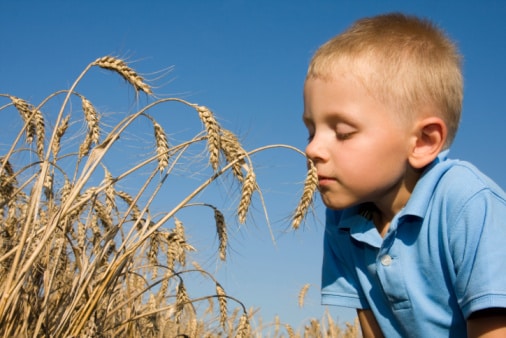Gluten And Other Food Allergies Are On The Rise In Children: Why?
 Gluten allergies, which differ from celiac disease, are on the rise in the United States. More and more children are showing signs of food allergies in general. While there is no definite answer yet, doctors are currently weighing between a combination of many environmental factors.
Gluten allergies, which differ from celiac disease, are on the rise in the United States. More and more children are showing signs of food allergies in general. While there is no definite answer yet, doctors are currently weighing between a combination of many environmental factors.
The number of children suffering from food allergies has increased 18% in the last two decades. The allergic reaction to wheat is considered relatively common, falling just behind milk, eggs, and peanuts as the most common allergies in children.
Dr. Ann Nowak-Wegrzyn, Associate Professor in Pediatrics of Allergy and Immunology at Mount Sinai Medical Center, tells me that the answer to what causes wheat allergies in children is “the million dollar question.”
When asked if children are indeed becoming more allergic to foods in general or whether we are just becoming more aware, Dr. Nowak-Wegrzyn confirms that both are steadily increasing.
Considering what science has already determined about allergies, she considers a variety of factors such as a hygiene hypothesis. The obsessive washing of hands, the consistent use of hand sanitizer, and other methods anchored in Westernized societies don’t allow children to be exposed to “normal” stimuli from the environment that regulate the immune system.
“What happens during pregnancy,” Dr. Nowak-Wegrzyn explains, “is that the immune system of the fetus is suppressed. When babies are born, they are immune deficient and are extremely sensitive to bacteria and infections. Immunizations ‘infect’ them over the first five years of life and the immune system goes under maturation. This kind of immune system is more prone to allergy.”
She points out that children raised in rural areas are more likely to be exposed to said bacteria, while children in urban areas often are not. According to Centers for Disease Control and Prevention, children with food allergy are two to four times more likely to have other related conditions such as asthma and other allergies, compared with children without food allergies.
Another hypothesis is how the increased use of sunscreen may be leading to a relevant deficiency of vitamin D regulators in the immune system, Dr. Nowak-Wegrzyn says.
“Children who are born in the winter season are more likely to have acute allergic reactions and food allergies than children born in the spring,” she notes, adding that there is also a notable allergy difference in children born in northern states and southern states.
When observing how much allergies have increased in general, Dr. Nowak-Wegrzyn also points to another increasing epidemic: c-sections. She tells me that babies born of c-sections show an increased reaction to diseases. Babies born through the vaginal canal are exposed to a beneficial amount of bacterial that seems to aid them in the long run.
Once the immune system does mature, many children do outgrow food allergies. Dr. Amanda Cox, Assistant Professor in the Pediatric Allergy Division at Mount Sinai Medical Center, cites a 2009 John Hopkins study that included 103 children. Researchers discovered that 65% of these children outgrew their wheat allergy by 12 years old. The average age at which they outgrew their wheat allergy was six and half years old.
“We do not really know why some children do outgrow their food allergies while others do not,” observes Dr. Cox. “This is an area of very active clinical research for all food allergies.”
Dr. Cox says that developing a tolerance to a food is ideal but that the “mainstay of treatment” as of now is strict dietary avoidance. Clinical trials investigating oral immunotherapy (introduction of gradually increasing amounts of a food in order to induce tolerance) are currently being conducted in the United States for milk, eggs, and peanuts, she says, but not for wheat.
“The bottom line is that wheat allergy should be monitored by an allergist over time, so that when and if the results of allergy testing suggest likely tolerance, wheat can safely be reintroduced, under physician supervision, into the diet,” adds Dr. Cox.
Despite some talk of gluten, as well as milk, causing behavorial issues such as ADHD and autism, Dr. Cox says that there is a lack of evidence supporting this link.
“There is no scientific evidence that supports this,” Dr. Nowak-Wegrzyn echoes, although she has assisted parents in the removal of gluten at their request.
Dr. Cox advises parents with gluten-allergic children to pay careful attention to packaged foods, an effort that has be made easier by the federal Food Allergen Labeling and Consumer Protection Act (FALCPA). The law requires that any packaged food product that contains wheat as an ingredient must list the word ”wheat” on the label.
Dr. Cox also provides parents with a list of ingredients that also indicate that wheat is present. She reviews alternate grains that may safely be maintained or added into their child’s diet.
“In addition to dietary avoidance measures, we review an emergency action plan, or how to treat an allergic reaction to an inadvertent exposure to wheat,” she explains. “All my patients with food allergies are instructed to carry an Epipen at all times, in case of anaphylaxis, and the indications and methods for using it are reviewed.”
She also advises parents to consider other things like school projects and crafts that may often involve wheat such as Play-Doh. Both commercially and home-made Play-Doh contain wheat flour and can be troublesome for young children who may put the Play-Doh in their mouths.
“Strangely enough,” she concludes, “this issue has actually come up for two of my patients in the last week.”






